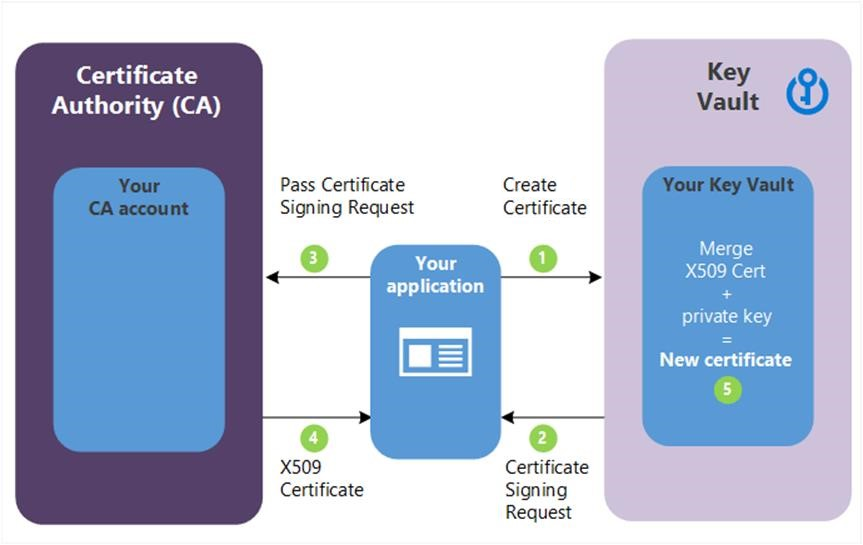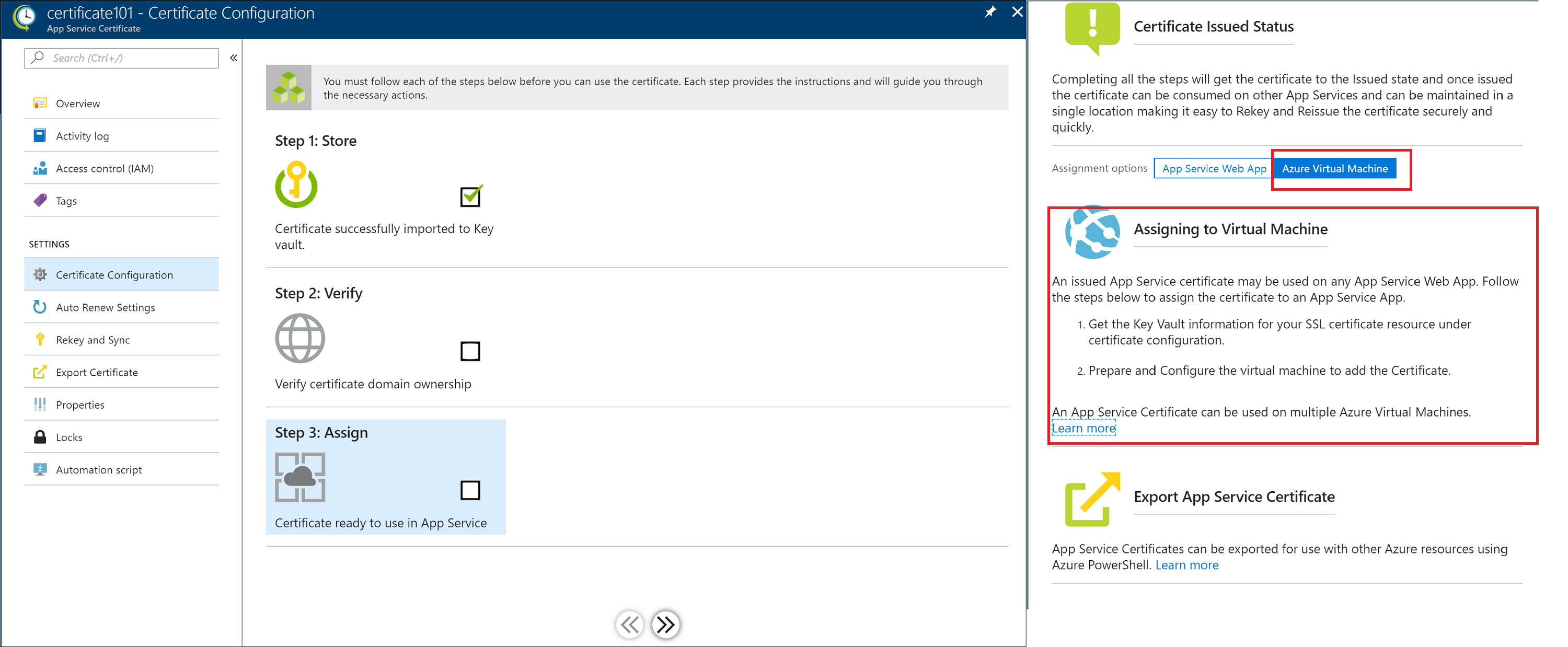Generate Ssl Certificate In Azure Key Vault
- Azure Generate Ssl Certificate
- Generate Ssl Certificate In Azure Key Vault Video
- Azure Add Ssl Certificate
- Generate Ssl Certificate In Azure Key Vault For Credentials
- Generate Ssl Certificate In Azure Key Vault Access Key For Storage
The following scenarios outline several of the primary usages of Key Vault’s certificate management service including the additional steps required for creating your first certificate in your key vault.

Azure Key Vault customers can order DigiCert SSL Certificates directly from their Key Vault account through the CertCentral REST API. Certificates are automatically renewed, making sure that lapses in SSL/TLS security don't happen.
- May 16, 2019 As part of the Azure App Service Certificate offering, we support Web Apps certificate deployment through Azure Key Vault. App Service Certificate stores the private certificate into a user-provided Key Vault secret. When App Service Certificate is deployed into a web app, a Web Apps resource provider deploys it from the Key Vault secret that's associated with App Service Certificate.
- I have created a web app and want to bind an SSL certificate stored as a secret from Azure Keyvault. At first, I have created a self-signed certificate and uploaded it to keyvault as a 'secret'. From the Azure Active Directory, I have created a web app and used the application ID to grant access to key vault.
The following are outlined:
- Creating your first Key Vault certificate
- Creating a certificate with a Certificate Authority that is partnered with Key Vault
- Creating a certificate with a Certificate Authority that is not partnered with Key Vault
- Import a certificate
Certificates are complex objects
Certificates are composed of three interrelated resources linked together as a Key Vault certificate; certificate metadata, a key, and a secret.
Creating your first Key Vault certificate
Before a certificate can be created in a Key Vault (KV), prerequisite steps 1 and 2 must be successfully accomplished and a key vault must exist for this user / organization.
Step 1 - Certificate Authority (CA) Providers
- On-boarding as the IT Admin, PKI Admin or anyone managing accounts with CAs, for a given company (ex. Contoso) is a prerequisite to using Key Vault certificates.
The following CAs are the current partnered providers with Key Vault:- DigiCert - Key Vault offers OV TLS/SSL certificates with DigiCert.
- GlobalSign - Key Vault offers OV TLS/SSL certificates with GlobalSign.
Step 2 - An account admin for a CA provider creates credentials to be used by Key Vault to enroll, renew, and use TLS/SSL certificates via Key Vault.
Step 3 - A Contoso admin, along with a Contoso employee (Key Vault user) who owns certificates, depending on the CA, can get a certificate from the admin or directly from the account with the CA.
- Begin an add credential operation to a key vault by setting a certificate issuer resource. A certificate issuer is an entity represented in Azure Key Vault (KV) as a CertificateIssuer resource. It is used to provide information about the source of a KV certificate; issuer name, provider, credentials, and other administrative details.
Ex. MyDigiCertIssuer
- Provider
- Credentials – CA account credentials. Each CA has its own specific data.
For more information on creating accounts with CA Providers, see the related post on the Key Vault blog.
Step 3.1 - Set up certificate contacts for notifications. This is the contact for the Key Vault user. Key Vault does not enforce this step.
Note - This process, through step 3.1, is a onetime operation.
Creating a certificate with a CA partnered with Key Vault
Step 4 - The following descriptions correspond to the green numbered steps in the preceding diagram.
(1) - In the diagram above, your application is creating a certificate which internally begins by creating a key in your key vault.
(2) - Key Vault sends an TLS/SSL Certificate Request to the CA.
(3) - Your application polls, in a loop and wait process, for your Key Vault for certificate completion. The certificate creation is complete when Key Vault receives the CA’s response with x509 certificate.
(4) - The CA responds to Key Vault's TLS/SSL Certificate Request with an X509 TLS/SSL Certificate.
(5) - Your new certificate creation completes with the merger of the X509 Certificate for the CA.
Key Vault user – creates a certificate by specifying a policy
Repeat as needed
Policy constraints
- X509 properties
- Key properties
- Provider reference - > ex. MyDigiCertIssure
- Renewal information - > ex. 90 days before expiry
A certificate creation process is usually an asynchronous process and involves polling your key vault for the state of the create certificate operation.
Get certificate operation- Status: completed, failed with error information or, canceled
- Because of the delay to create, a cancel operation can be initiated. The cancel may or may not be effective.
Azure Generate Ssl Certificate
Import a certificate
Alternatively – a cert can be imported into Key Vault – PFX or PEM.

How do i generate an ssh key in windows 10. Import certificate – requires a PEM or PFX to be on disk and have a private key.
You must specify: vault name and certificate name (policy is optional)
PEM / PFX files contains attributes that KV can parse and use to populate the certificate policy. If a certificate policy is already specified, KV will try to match data from PFX / PEM file.
Once the import is final, subsequent operations will use the new policy (new versions).
If there are no further operations, the first thing the Key Vault does is send an expiration notice.
Also, the user can edit the policy, which is functional at the time of import but, contains defaults where no information was specified at import. Ex. no issuer info
Formats of Import we support
We support the following type of Import for PEM file format. A single PEM encoded certificate along with a PKCS#8 encoded, unencrypted key which has the following
-----BEGIN CERTIFICATE----------END CERTIFICATE-----
-----BEGIN PRIVATE KEY----------END PRIVATE KEY-----
On certificate merge we support 2 PEM based formats. You can either merge a single PKCS#8 encoded certificate or a base64 encoded P7B file.-----BEGIN CERTIFICATE----------END CERTIFICATE-----
We currently don't support EC keys in PEM format.
Creating a certificate with a CA not partnered with Key Vault
/far-cry-3-cd-key-generator-download.html. This method allows working with other CAs than Key Vault's partnered providers, meaning your organization can work with a CA of its choice.
The following step descriptions correspond to the green lettered steps in the preceding diagram.
Generate Ssl Certificate In Azure Key Vault Video
(1) - In the diagram above, your application is creating a certificate, which internally begins by creating a key in your key vault.
(2) - Key Vault returns to your application a Certificate Signing Request (CSR).
Azure Add Ssl Certificate
(3) - Your application passes the CSR to your chosen CA.
Generate Ssl Certificate In Azure Key Vault For Credentials
(4) - Your chosen CA responds with an X509 Certificate.
Generate Ssl Certificate In Azure Key Vault Access Key For Storage
(5) - Your application completes the new certificate creation with a merger of the X509 Certificate from your CA.